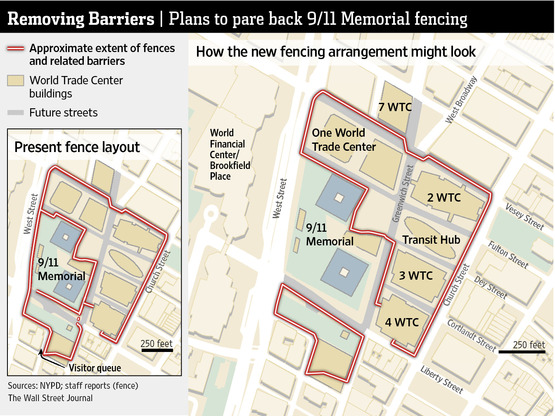By Keiko Morris Wall Street Journal

Plans for 9/11 Memorial fencing
One of the big events of this year: dismantling a blue fence.
The redevelopment of the World Trade Center is expected to pass a major milestone in 2014, but one that will be more low-key than others ticked off in recent years such as the opening of the 9/11 Memorial or completing the spire atop One World Trade Center.
For 13 years, the 16-acre site has been fenced off from the rest of Downtown as the rebuilding process has continued. The memorial opened two years ago, but access has been limited to ticketed visitors who pass through the fence on a narrow walkway.
In 2014, portions of the fence will be dismantled, enabling people to go back and forth freely between the memorial and parts of downtown, according to Joe Daniels, president of the National September 11 Memorial & Museum. He said he is “100%” sure it will happen this year, perhaps as early as May when the 9/11 Memorial Museum on the site is scheduled to open.
The exact timing on the fence removal, though, remains unclear. A spokesman for the Port Authority of New York and New Jersey, which owns the site, declined to comment.
But earlier this month, at a meeting of the downtown community board, a Port Authority representative said possible plans for fencing removal this year would include the west side of the memorial plaza along West Street, the south end along Liberty Street and a portion of Greenwich Street, according to a person who attended the meeting.
Downtown residents, business owners and landlords have long awaited the blending of the site into the neighboring streets. Once it happens, travel will be easier, more people will want to live and work there and an important psychological step will be taken in healing from the trauma of September 11, they said.
“It’s something I have been looking forward to for a long time,” said September 11 memorial designer Michael Arad. “The design of the memorial has always been about connecting the site back to the city and making this part of the city whole again.”
But like most everything else at the World Trade Center site, the removal of the barriers isn’t without controversy or complications. While most officials agree the fence will begin to come down this year, the exact plan, timing and security precautions remain unclear.
Some residents are concerned that, even after the fences start to come down, security concerns will prevent the site from being woven into the city’s fabric. Indeed, a group of downtown residents recently went to court to block a plan for controlling vehicle access to the site, warning that it would create “an isolated fortress” downtown.
“Any fence coming down is a good thing” said Mary Perillo[,] founder of the World Trade Center Neighborhood Alliance and a 30-year resident of the area. “But I can’t see the NYPD giving up searching people.”
A New York Police Department spokesman referred questions about the fence to the Port Authority. In a statement, Joe Dunne, the Port’s chief security officer, said decisions regarding the fence will “consider ongoing construction needs and other concerns but will keep the safety of visitors and the general public as the top priority.”
The full integration of the World Trade Center site into downtown is still years away. The transportation hub designed by Spanish architect Santiago Calatrava isn’t scheduled to be completed until the beginning of 2015. The opening of Greenwich Street, which runs through the site, partly depends on the construction of the transportation hub and 3 World Trade Center.
But people who live and work in the area said the dismantling of the fence will be a big step in the rebuilding because it will incorporate the memorial plaza into daily life. Today, tourists and others typically plan to visit the memorial, named “Reflecting Absence,” to pay respect to the thousands who died in the terrorist attack.
With the fences down, the eight-acre site also will become more of a park. Workers will go there between appointments or to grab a quick bite or a cup of coffee. Pedestrians will traverse it as they walk through the area.
“It hasn’t been part of normal New York City life for a while,” said Joe Lincks, 47, of Mahopac, N.Y., an insurance underwriter who has worked in Lower Manhattan for 25 years.
Downtown landlords in particular are eager to see the fences come down. For years, their tenants have had to put up with the clogged sidewalks and other hassles of being near the massive construction site.
The downtown office market has rebounded with the rest of Manhattan as the city’s economy has improved. Average rents increased to $48.26 in the fourth quarter of 2013 from $38.78 in 2010, according to Cushman & Wakefield Inc.
But the vacancy grew to 12.2% in 2013 from 8.8% in 2012, in part because of space being added by new construction.
People involved in the leasing of the new World Trade Center towers predict the removal of the fence will give leasing a boost.
“People have felt banished up until now,” said Jody Durst, president of the Durst Organization, which helped develop One World Trade Center.
Mr. Arad, the memorial designer, said “Reflecting Absence” is supposed to be integrated with surrounding streets so the city would remember the September 11 victims as a part of everyday life.
“If you are a visitor to the memorial and see an office worker sitting on a bench, you can’t help but think that it was people like them who were targeted and have their names on the panels,” Mr. Arad says. “It underscores the importance of what the memorial is about and who is being commemorated.”
–Jennifer Maloney contributed to this article.

